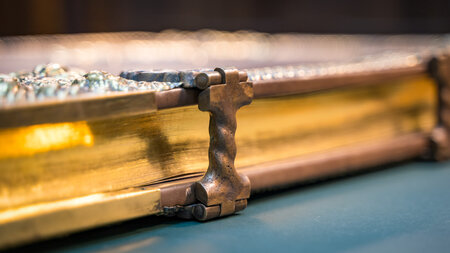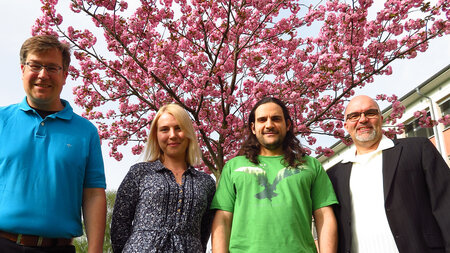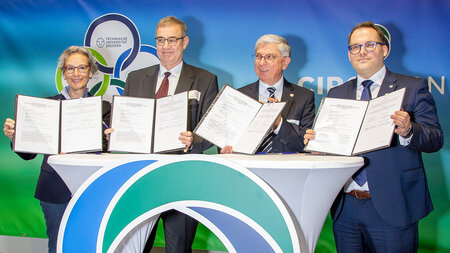"Weight-loss plan" for Municipal Utility Vehicles
Scientists at the Department of Lightweight Structures and Polymer Technology at Chemnitz University of Technology are developing resource-efficient collection containers for e-garbage trucks
-
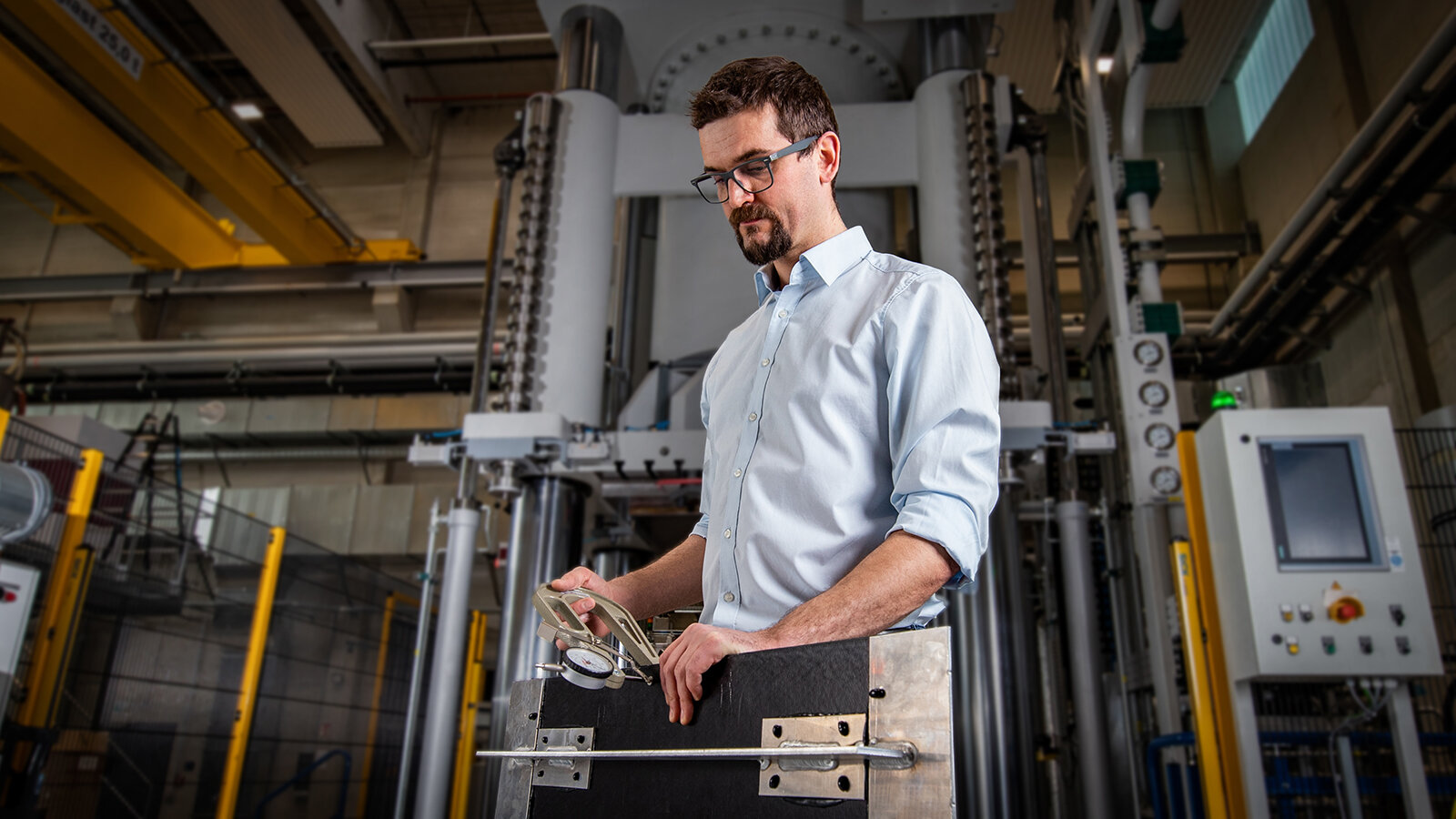
Marcus Hartenstein, research associate at the SLK department, checks the thickness of an organic sheet. This element of the innovative waste container was manufactured with a press force of 25,000 kN on a Wickert composite press, which can be seen in the background, at the MERGE Research Centre “Lightweight Technologies” at Chemnitz University of Technology. Photo: Jacob Müller -
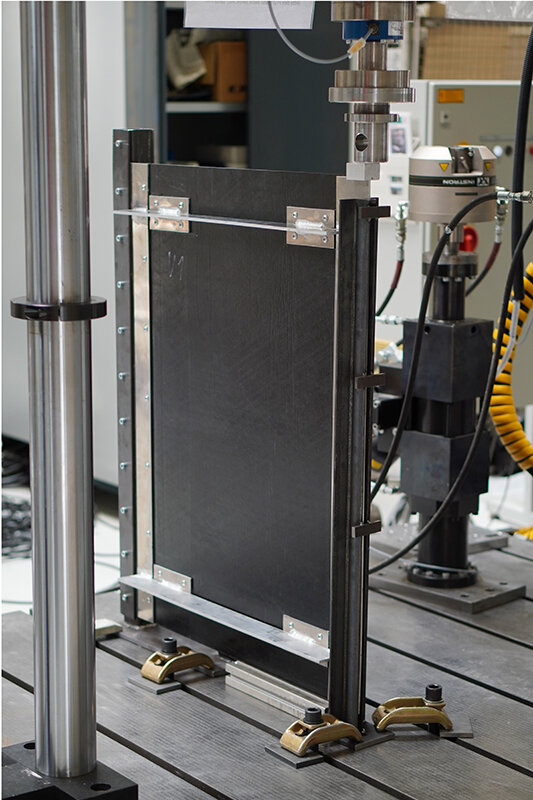
Repeated simulations, carried out on a structural test bench in the new laboratory building of the MERGE Research Centre “Lightweight Technologies” ,provide proof of performance. Photo: Chemnitz University of Technology/SLK -
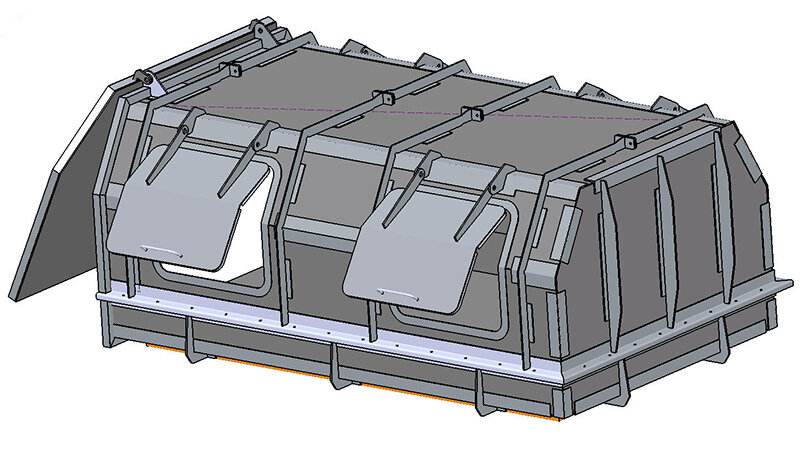
This is what the finished collection container will look like. The structural concept was created on the computer with the help of simulation software. Graphic: Chemnitz University of Technology/SLK
The drive of the future is electric. Electric motors offer numerous advantages, such as increased environmental friendliness, lower operating costs, and reduced noise pollution. Due to these advantages, they are now also being phased in by municipalities, which are converting their commercial vehicles to the modern drive technology. In doing so, they are being supported by scientists from the Department of Lightweight Structures and Polymer Technology (SLK) at Chemnitz University of Technology, who are currently fine-tuning the development of a new type of ultra-lightweight collection container for electric waste vehicles. "Particularly in short-haul operation, when it is necessary to stop and accelerate frequently, electric vehicles of up to 3.5 tons are more efficient than conventional internal combustion vehicles," explains Marcus Hartenstein, a researcher at the SLK department. With regard to the public tasks municipalities are concerned with, this applies, among other things, to the garbage trucks used for waste disposal.
Extremely light and stable containers to compensate for battery weight
Particularly in vehicles where the highest possible payload is one of the key requirements, the benefits of electric vehicles have so far been offset by a major disadvantage: The battery weight of 200 to 300 kilograms means that the load that can be transported is insufficient. To compensate for this loss of payload, scientists at Chemnitz University of Technology have joined forces with five other research and industrial partners in the R&D project UTILITAS (Ultralight Body Structures for Commercial Vehicles in Municipal Service Operations) to develop a container system that is not only extremely lightweight, but also economical and easy to manufacture. The researchers at the SLK department are responsible for the design of the container. This includes its structure, dimensions and rough layout as well as all the necessary calculations. Since the container has to withstand high loads, the department must also verify its performance. To ensure that high payloads can be carried, the stresses are repeatedly simulated on the structural test bench at Chemnitz University of Technology’s MERGE Research Centre “Lightweight Technologies”.
Great demand for lightweight solutions – companies offered know-how
Questions of economic sustainability, future living environments, and the effects of climate change on people are increasingly in focus at the local level. Due to this, the demand for possible technologies which offer potentials for resources saving at all levels has increased significantly. "During the exploratory talks for the project, further needs in municipal service operations have already become clear, such as in the management of green areas or in vehicles for leaf blowing and leaf vacuuming. Last but not least, e-vehicles also save on the diesel generator here," reports Hartenstein. Due to this increasing demand, a central aspect of the project is also to generate know-how for companies and to support them by providing relevant data to generate greater freedom in material selection and joining technology.
High-performance organic sheets offer advantages
In order to help local authorities achieve their climate protection targets with the resources available locally, the focus in the development of the waste container and the associated manufacturing technology is on cost-effectiveness. The scientists are relying on a modular and thus adaptable container system composed of a frame structure and fiber-reinforced plastic sheets. These so-called organic sheets, made of the ThermoPre material also developed at Chemnitz University of Technology, offer numerous advantages due to their high performance and a layer structure that is tailored to requirements. At the same time, no forming is required, which ensures simple construction and repair and keeps investment costs low, even for small quantities. Various joining strategies were tested to reliably connect the modules including bolting, gluing and a mixed construction method, which was chosen as the final solution due to its high practicality.
"The first electric waste transporters equipped with the innovative container system could soon be in use," says Hartenstein. A demonstrator vehicle has already been built and the simulation has been completed. "Now it's a matter of completing final design tasks and putting the container into production," the scientist is pleased to say. "A prototype for municipal utility operation should be completed as early as the first half of 2021 and tested in everyday practice. Subsequently, depending on the number of orders, we are aiming for serial production.”
Strong partners in the network
In addition to Chemnitz University of Technology, the Fraunhofer Institute for Material and Beam Technology IWS Dresden, EBF Innovation GmbH, PROFIL Verbindungstechnik GmbH & Co. KG, Car systems Scheil GmbH & Co. KG, and Marko Pfaff & Co. Spezialfahrzeugbau GmbH are part of this project. IWS Dresden developed a new joining technology specifically for the project, which is being implemented with the help of EBF Innovation GmbH and PROFIL Verbindungstechnik GmbH & Co. KG. The electronics required for tilting and controlling the container system are being implemented by Car systems Scheil GmbH & Co. KG, while Marko Pfaff & Co. Spezialfahrzeugbau GmbH is looking at the development from a manufacturing perspective.
The project is funded by the German Federal Ministry for Economic Affairs and Energy within the framework of the specialist program “New Vehicle and System Technologies" as part of the program pillar "Innovative Vehicles" and is supervised by TÜV Rheinland.
Contact: Marcus Hartenstein, Phone +49 371 531-39483, E-mail marcus.hartenstein@mb.tu-chemnitz.de
(Author: Eva Laurie/Translation: Chelsea Burris, Eva Laurie)
Matthias Fejes
09.02.2021


